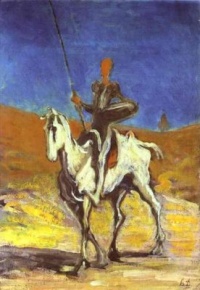Quixotism
From The Art and Popular Culture Encyclopedia
| Revision as of 18:29, 7 April 2014 Jahsonic (Talk | contribs) ← Previous diff |
Current revision Jahsonic (Talk | contribs) |
||
| Line 1: | Line 1: | ||
| [[Image:Don Quixote and Sancho Pansa by Honoré Daumier.jpg|thumb|200px|right|''[[Don Quixote (Honoré Daumier, Neue Pinakothek)|Don Quixote]]'' (c. 1868) by [[Honoré Daumier]]]] | [[Image:Don Quixote and Sancho Pansa by Honoré Daumier.jpg|thumb|200px|right|''[[Don Quixote (Honoré Daumier, Neue Pinakothek)|Don Quixote]]'' (c. 1868) by [[Honoré Daumier]]]] | ||
| {{Template}} | {{Template}} | ||
| - | '''Quixotism''' (adj. quixotic) is impracticality in pursuit of [[ideal]]s, especially those ideals manifested by rash, lofty and romantic ideas or extravagantly chivalrous action. It also serves to describe an [[idealism]] without regard to [[practical]]ity. An impulsive person or act might be regarded as quixotic. | + | '''Quixotism''' (adj. quixotic) is impracticality in pursuit of [[ideal]]s, especially those ideals manifested by [[rash]], [[lofty]] and [[romantic]] ideas or [[extravagant]]ly [[chivalrous]] action. It also serves to describe an [[idealism]] without regard to [[practical]]ity. An [[impulsive]] person or act might be regarded as quixotic. |
| Quixotism is usually related to "over-idealism", meaning an idealism that doesn't take consequence or absurdity into account. It is also related to naïve [[romanticism]] and to [[utopianism]]. | Quixotism is usually related to "over-idealism", meaning an idealism that doesn't take consequence or absurdity into account. It is also related to naïve [[romanticism]] and to [[utopianism]]. | ||
| Line 15: | Line 15: | ||
| == See also == | == See also == | ||
| + | *[[Auctorial descriptives ]] | ||
| *[[Tilting at windmills]] | *[[Tilting at windmills]] | ||
| {{GFDL}} | {{GFDL}} | ||
Current revision
|
Related e |
|
Featured: |
Quixotism (adj. quixotic) is impracticality in pursuit of ideals, especially those ideals manifested by rash, lofty and romantic ideas or extravagantly chivalrous action. It also serves to describe an idealism without regard to practicality. An impulsive person or act might be regarded as quixotic.
Quixotism is usually related to "over-idealism", meaning an idealism that doesn't take consequence or absurdity into account. It is also related to naïve romanticism and to utopianism.
Origin
Quixotism as a term or a quality appeared after the publication of El ingenioso hidalgo don Quijote de la Mancha in 1605. Don Quixote, the hero of this novel, written by Spanish author Miguel de Cervantes Saavedra, dreams up a romantic ideal world which he believes to be real, and acts on this idealism, which most famously leads him into imaginary fights with windmills that he regards as giants.
Already in the 17th century the term Quixote was used to describe a person that does not distinguish between reality and imagination. The poet John Cleveland wrote in 1644, in his book The character of a London diurnall:
- "The Quixotes of this Age fight with the Wind-mills of their owne Heads"
The word Quixotism is mentioned, for the first time, in Pulpit Popery, True Popery (1688):
- "All the Heroical Fictions of Ecclesiastical Quixotism"
See also


